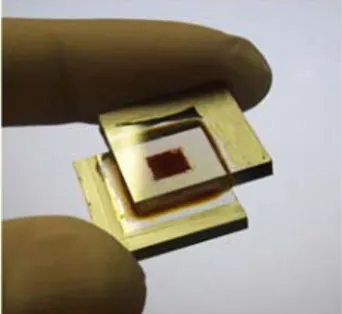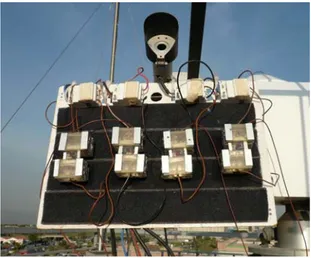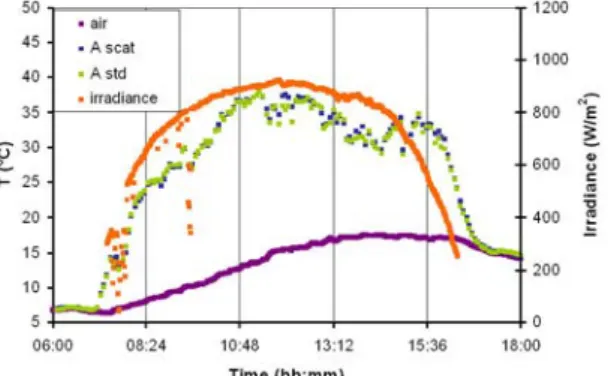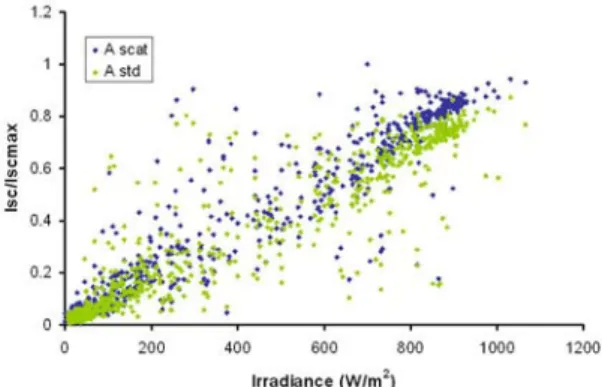OUTDOOR CHARACTERIZATION OF DYE SOLAR CELLS: FIRST RESULTS C. Cornaro1,2, A. Spena1,2 , T. M. Brown2,3, A. Di Carlo2,3, A. Reale2,3, S. Martella3
1Department of Enterprise Engineering 2CHOSE, Centre for Hybrid and Organic Solar Energy
3Department of Electronic Engineering University of Rome Tor Vergata Via del Politecnico, 1, 00133 Rome, ITALY
[email protected], [email protected],
ABSTRACT: The Centre for Hybrid and Organic Solar Energy (CHOSE) at the University of Rome Tor Vergata is focusing its efforts in developing reliable and stable dye solar cells and modules. The CHOSE development program foresees that new cells and modules will be tested both indoor and outdoor in order to have an overview of the real performances of the devices. This is generally a key point for a correct evaluation of the actual performances of any photovoltaic technology. In October 2008 an outdoor measurement campaign on Dye Solar Cells has been started. Two different types of cells have been built in the laboratory, varying the characteristics of the TiO2 film, in order to evaluate their behaviour in real outdoor environment. Data collected during the two first month of outdoor cell exposure are presented in this paper. Daily trends of cell efficiency as a function of the environmental parameters and of the cell temperature have been investigated, focusing on the cell behaviour at low irradiance levels.
Keywords: Dye-Sensitised, Monitoring, Organic Solar Cell. 1 INTRODUCTION
Dye solar cells (DSCs) [1] show great promise as an alternative cheap photovoltaic technology. EPIA recognized DSCs as one of the most promising new generation photovoltaic technology and literature on this topic is also growing very fast. Building Integrated Photovoltaic (BIPV) is the most suitable application for DSC and efforts have been made by CHOSE and other research groups in Europe [2], to develop semitransparent DSC modules for facades applications.
Identification of suitable qualification tests is fundamental for the future introduction of a new technology like that of DSCs. Especially for innovative devices including thin film, DSCs and fully organic photovoltaic systems, the restriction to their characterization at Standard Test Conditions (STC) can be a limiting factor or even lead to erroneous evaluation of their performances in real outdoor conditions.
The FTA Laboratories of the University of Tor Vergata provides support to CHOSE for the outdoor test of dye solar cells and modules [3]. Recently, a preliminary explorative outdoor test on DSCs has been carried out and presented elsewhere [4]. In the view of the definition of an indoor - outdoor monitoring strategy for dye cells and modules, in October 2008 a more extensive measurement campaign has been carried out mainly to check the high sensitivity of DSC to diffuse radiation [2] and to test the performance of TiO2 film with different morphological characteristics.
2 EXPERIMENTAL 2.1 Dye Solar Cell construction
Two identical cells, named Astd and Bstd, were constructed using the substrates of 8 Ω/□ FTO-glass (2 x 2 cm, Pilkington) cleaned in an ultrasonic bath for 10 min with acetone and 5 min with ethanol. 0.5 x 0.5 cm TiO2 films were deposited via blade coating using Degussa Aeroxide P25 TiO2 paste. The gap between blade and substrate was of 150μm. The substrates were subsequently dried for 5 minutes at 65 °C and then
sintered using a temperature ramp with a last step at 525°C for 30 min, the resulting dry films present a thickness of ~ 15μm. After sintering, the substrates were put into a 0.5 mM N719 (Solaronix) dye solution in ethanol for 15 h. After soaking in the dye solution the substrates were rinsed in ethanol. Counter electrodes were prepared by brushing a Pt precursor solution (Platisol, Solaronix) onto the FTO-coated substrates and then annealed at 400°C for 5 minutes. The cells were completed by sealing together the two electrodes via a 60 μm thick Surlyn gaskets. Dyesol HSE electrolyte was inserted into the cell via vacuum backfilling.
Other two cells, named Ascat and Bscat, were built with the same procedure but introducing a second TiO2 layer constituted by a combination of P25 and T300 pastes. This second layer should increase the scattering of solar radiation into the cell optimizing radiation collection. Figure 1 shows one of the cells built.
Figure 1: View of one of the cells built at the CHOSE laboratory for the outdoor campaign.
2.2 Outdoor measurements
The cells have been characterized at the ESTER facility of the FTA Laboratories. The outdoor experimental layout is shown in fig. 2.
The four DSC cells have been mounted on a high precision sun tracker (Kipp & Zonen) so that they followed the sun during the test (fig. 2). This configuration guarantees the cell normal incidence to direct solar radiation so that no influence of the angle of
24th European Photovoltaic Solar Energy Conference, 21-25 September 2009, Hamburg, Germany
incidence has to be take into account. Each cell has been provided with a fine K thermocouple junction glued on the back side, to measure cell temperature.
Figure 2: Experimental layout of the outdoor test on DSC cells.
The data acquisition system consists on a custom electronic board that forces the cell to work at the maximum power point and can trace the IV curve at the scheduled time. The board is connected to a NI cDAQ-9172 module and the thermocouples are measured by a NI 9211 module. The hardware is managed by a self made Labview program that allows to continuously monitor the cells measuring Pmax with a time rate of 5 minutes and tracing a complete IV curve every 20 minutes.
The separate components of solar radiation are measured with a minute time rate by a different system (the meteo solar station) using a high precision pyrheliometer (direct component), a shaded high precision pyranometers (diffuse component) and an upside down high precision pyranometer (reflected component); global irradiance on the plane of the cells have been derived using the isotropic solar radiation transposition model [5]. Air temperature and wind speed and direction are also measured every minute.
Figure 3: Irradiance and air temperature daily trends for the first fifteen days of November 2008.
The campaign started on the 21st October 2008 and ended on 26th November 2008. Before and after outdoor
exposure, the indoor IV curves at reference conditions have been traced for each cell to verify their stability. Figure 3 shows, as an example, the in plane irradiance and air temperature experienced during the first fifteen days of November.
Figure 4: Irradiance and cell efficiency trends for a clear day.
Cells efficiency and temperature have been monitored during the test period. A different trend as been observed for the different cells under test, influenced by their structure and by the climatic conditions. In figure 4 and 5 the cells relative efficiency daily trend is shown, respectively for a clear day and an overcast day. For the clear day a slight higher efficiency is observed for the Ascat cell with respect to the Astd one. Moreover this difference is more visible in the morning than in the afternoon. The overcast day exhibits high efficiency values but the difference between the two cell types are not easily recognizable. Both cells show a good performance at low irradiance while at normal incidence and with clear sky conditions Ascat type exhibits a better behaviour. This can be due to the scattering layer that optimize the energy conversion of the irradiance direct component.
Figures 6 and 7 report cells temperature with irradiance and air temperature daily trends, for a clear day and an overcast day, respectively.
Figure 5: Irradiance and efficiency daily trends for an overcast day.
For the clear day the combined effect of radiation and convection justify the trend (the second maximum observed in cell temperature at relatively low irradiance values has been explained by a sudden decrease in the wind speed daily trend). Not noticeable differences between the temperature of the two cells types have been
24th European Photovoltaic Solar Energy Conference, 21-25 September 2009, Hamburg, Germany
observed for both clear days and overcast days.
Figure 6: Cells temperature, air temperature and irradiance for a clear day.
Figure 7: Cells temperature, air temperature and irradiance for an overcast day.
3 RESULTS 3.1 Cell temperature
As pointed out in [7], DSC module and cell temperature peak values and trends are important parameters to monitor at different climatic conditions and locations to evaluate the devices duration and stability. As previously showed and expected, cell temperature does not change appreciably among the two cell types. Considering the Ascat cell type, a maximum temperature, Tdscmax = 45.9 ± 0.2 °C has been observed on the 24th of October at 11:16 am at irradiance, G = 844 ± 24 W/m2 and Tair = 22.6 ± 0.2 °C.
Figure 8 shows the difference between cell temperature and air temperature versus irradiance for the Ascat cell; a linear trend can be recognized. A temperature difference of 18.6 °C has been derived at G = 1000 W/m2.
Astd cell exhibits the same trend with a temperature difference of 18.04 °C at G = 1000 W/m2.
3.2 Cell efficiency
DSC cell efficiency, as for silicon cells, depends on many parameters: not only on irradiance and temperature, but also on air mass, solar spectrum and angle of incidence. As a first attempt to characterize the cells behavior and the differences among the cells construction materials, air mass and spectrum have been
neglected; angle of incidence has no influence due to normal incidence mounting.
Figure 8: Difference between cell temperature and air temperature versus irradiance for Ascat cell.
Cell efficiency sensitivity to irradiance has been evaluated for the two cells and the results are shown in figure 9, fixing the cell temperature in the range 19 – 21°C. Data appears quite spread, probably because a considerable number of days have experienced high irradiance instability, however both dataset show an increment in relative efficiency in the range of low irradiance, till approximately 200 W/m2. Such behavior is mentioned in the literature for DSC modules [2] and has been observed in some measurements made by the authors during the same period on a DSC module prototype.
Figure 9: Efficiency versus irradiance at fixed temperature for Ascat and Astd cells.
3.3 Cell Isc and Voc
During the outdoor monitoring IV curves have been traced every 20 minutes and Isc, Voc, FF have been determined. Figure 10 shows the trend of relative Isc for Ascat and Astd versus irradiance. A linear trend is clearly recognizable for both cells and also an increment in Isc at high irradiance level is evident. This confirms the better behavior of Ascat at high irradiance, mainly corresponding to clear sky and higher direct component contribution to global radiation. The high data dispersion at medium irradiance should be related to weather instability as already observed for relative efficiency. This could indicate a sort of delay in cell response to irradiance rapid variation, in fact low and high irradiance are more representative of stable clear and overcast days.
24th European Photovoltaic Solar Energy Conference, 21-25 September 2009, Hamburg, Germany
Figure 11 shows the trend of relative Voc versus irradiance for both cells. In this case the two cells show the same trend and at irradiance higher than 200 W/m2, where Voc is constant.
The fill factor FF remains mostly stable during the test and for both cells is approximately 70%.
Figure 10: Isc versus irradiance for Ascat and Astd cells.
Figure 11: Voc versus irradiance for Ascat and Astd cells.
3.4 Diffuse radiation component influence
To check the behavior of the cells at prevailing diffuse radiation component, the ratio of the diffuse radiation over the global radiation (cloud ratio) have been used as indicator and has been associated to the cells efficiency. The cloud ratio ranges from 0 (that corresponds to clear sky) to 1 (corresponding to overcast sky). This range has been divided into five categories and for each of them the average cell efficiency has been calculated. Figure 12 shows the results for the Ascat and Astd cells (cell temperature ranges between 19 and 21°C).
For both cells the maximum efficiency corresponds to the cloud ratio ranging from 0.6 to 0.8, confirming the best response of these cells to the diffuse radiation. Unfortunately not much can be said on the difference between the two cell types. Only in the range between 20% and 40% of diffuse over global irradiance the difference between the two cells has some significance. In this case Ascat performs better than Astd. For Ascat, solar radiation collection at high direct irradiance contribute, due to the scattering layer, could justify this behavior. Another confirmation to this result is given by the fact that this trend has been observed at various temperature ranges.
Figure 12: Efficiency versus cloud ratio for Ascat and Astd cells.
3.5 Stability
The cells stability has been checked through IV curve tracing at reference conditions before and after the outdoor exposure. Both cells did not show any degradation effect due to the outdoor exposure.
4 CONCLUSIONS
A two months outdoor measurement campaign on first generation DSC cells made by CHOSE has been carried out in Autumn 2008. Objective of the campaign was to better understand the behaviour of organic cells in the real environment and to verify the solar radiation collection capability of a scattering TiO2 paste with respect to a standard one.
The influence of the environmental variables have been studied indicating a possible better behaviour of this devices at low irradiances. No evident trend of the cells performances with respect to the cell temperature has been observed for this specific test, even if this parameter should have an important role.
Concerning the behaviour of the scattering TiO2 paste, a higher efficiency (almost of 10%) has been observed in the clear days and high irradiance values indicating a higher collection efficiency of the direct solar radiation component due to scattering in the paste.
Further tests have been planned for the next year on second generation DSC cells produced by CHOSE in order to better clarify what here observed.
5 REFERENCES
[1] M. Graetzel, Nature, 421, (2003), pp.586-587. [2] A. Hinsch, H. Brandt, W. Veurman, S. Hemming, M.
Nittel, U. Wurfel, P. Putyra, C. Lang-Koetz, M. Stabe, S. Beucker, K. Fitcher. Solar Energy Materials and Solar Cells, vol. 93, (2009), 820-824.
[3] A. Spena, C. Cornaro, S. Serafini. Proceedings 33rd IEEE PV Specialist Conference, San Diego (CA), May, 11-16 (2008).
[4] C. Cornaro, A. Spena, T.M. Brown., A. Di Carlo and A. Reale. Proceedings of the 33rd IEEE PV specialists Conference, San Diego (CA), May, 11-16 2008.
[5] B. Y. H.Liu, R.C. Jordan. Solar Energy, vol. 4, (3), (1960).
24th European Photovoltaic Solar Energy Conference, 21-25 September 2009, Hamburg, Germany



